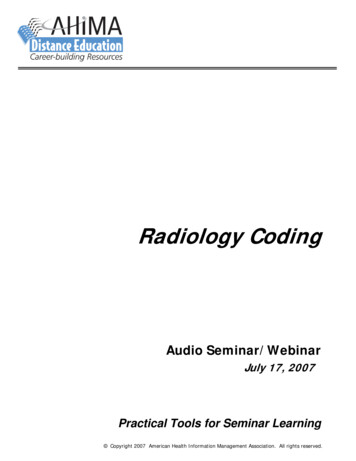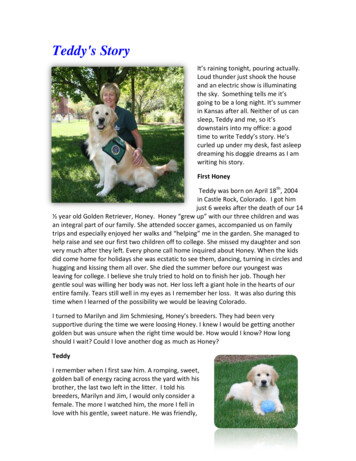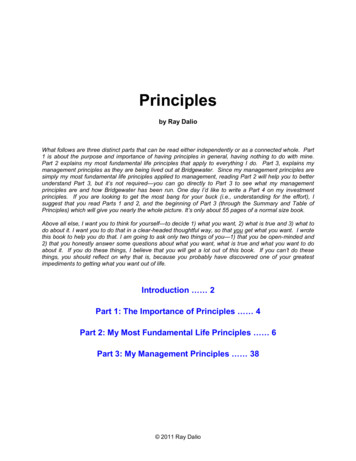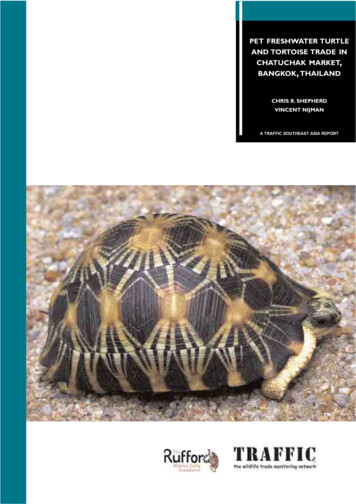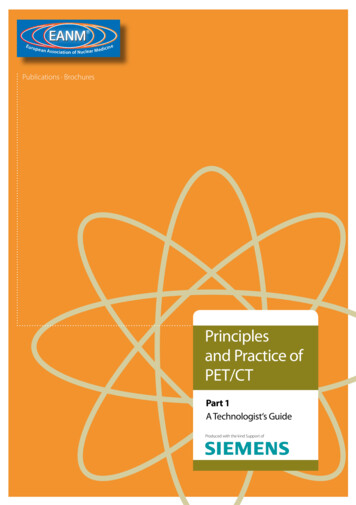
Transcription
E urEANM o p e anA s s o ci atio n o f N u cl e a r M e d icin ePublications · BrochuresPrinciplesand Practice ofPET/CTPart 1A Technologist‘s GuideProduced with the kind Support of
EditorsPeter HoggHead of Diagnostic Imaging ResearchUniversity of SalfordSalford, UKGiorgio TestaneraIstituto Clinico HumanitasDepartment of Nuclear MedicineRozzano, ItalyContributorsSuzanne DennanDepartment of Diagnostic ImagingSt. James Hospital, Dublin, IrelandAnn HeathcoteRegional MangerAlliance Medical LimitedWarwick, UKThomas KaneConsultant in Radiology & Nuclear MedicineVictoria Hospital, Blackpooland Lancashire PETCT Centre, Preston, UKAmy WareingSenior PET CT TechnologistPreston PET CT CentreRoyal Preston HospitalLancashire Teaching Hospitals, UKJean-Marc VrigneaudMedical PhysicistNuclear Medicine DepartmentCentre Georges-François LeclercDijon, FrancePeter JulyanClinical ScientistNorth Western Medical PhysicsThe Christie NHS Foundation Trust, UKSylvianne PrevotRadiation Safety OfficerCentre Georges-Francois LeclercDijon, FranceKaty SzczepuraMedical Physics LecturerDepartment of Diagnostic RadiographyUniversity of SalfordGreater Manchester, UKAngela MeadowsUnit ManagerPreston PET/CT CentreAlliance MedicalRoyal Preston HospitalLancashire Teaching Hospitals NHS Trust, UKSimona ColaTechnologist of the Department of NuclearMedicineS. Maria Nuova HospitalReggio Emilia, ItalyRonald BoellaardAssociate Professor and Head of PhysicsDepartment of Nuclear Medicine and PETResearchVU University Medical CentreAmsterdam, The Netherlands2
EANMContentsForewordSuzanne Dennan. . . . . . . . . . . . . . . . . . . . . . . . . . . . . . . . . . . . . . . . . . . . . . . . . . . . . . . . . . . . . . . . . . . . . . . . . . . . . . . . . . . . . . . . 4Preface and Glossary of Terms and AbbreviationsPeter Hogg and Giorgio Testanera . . . . . . . . . . . . . . . . . . . . . . . . . . . . . . . . . . . . . . . . . . . . . . . . . . . . . . . . . . . . . . . . . . . . . . . 5Chapter 1: The value and limitations of PET-CT in routine clinical practice:a UK radiologist’s perspectiveThomas Kane and Peter Hogg. . . . . . . . . . . . . . . . . . . . . . . . . . . . . . . . . . . . . . . . . . . . . . . . . . . . . . . . . . . . . . . . . . . . . . . . . . . 7Chapter 2: Practical radiation protection in PET-CTJean-Marc Vrigneaud, Sylvianne Prévot, Angela Meadows and Peter Hogg . . . . . . . . . . . . . . . . . . . . . . . . . . . . . 16Chapter 3: PET imaging instrumentation and principles of PET protocol optimisationRonald Boellaard. . . . . . . . . . . . . . . . . . . . . . . . . . . . . . . . . . . . . . . . . . . . . . . . . . . . . . . . . . . . . . . . . . . . . . . . . . . . . . . . . . . . . . . 37Chapter 4: CT instrumentation and principles of CT protocol optimisationAnn Heathcote, Amy Wareing and Angela Meadows. . . . . . . . . . . . . . . . . . . . . . . . . . . . . . . . . . . . . . . . . . . . . . . . . . . 54Chapter 5: Quality assurance and quality control for PET-CTPeter Julyan . . . . . . . . . . . . . . . . . . . . . . . . . . . . . . . . . . . . . . . . . . . . . . . . . . . . . . . . . . . . . . . . . . . . . . . . . . . . . . . . . . . . . . . . . . . 69Chapter 6: PET isotope productionKaty Szczepura. . . . . . . . . . . . . . . . . . . . . . . . . . . . . . . . . . . . . . . . . . . . . . . . . . . . . . . . . . . . . . . . . . . . . . . . . . . . . . . . . . . . . . . . 76Chapter 7: Patient care in PET-CTSimona Cola and Peter Hogg. . . . . . . . . . . . . . . . . . . . . . . . . . . . . . . . . . . . . . . . . . . . . . . . . . . . . . . . . . . . . . . . . . . . . . . . . . 81Chapter 8: Radiographer and technologist competencies – education and training in PET-CTPeter Hogg and Angela Meadows . . . . . . . . . . . . . . . . . . . . . . . . . . . . . . . . . . . . . . . . . . . . . . . . . . . . . . . . . . . . . . . . . . . . . 88Imprint 993
ForewordSuzanne DennanThe EANM Technologist Committee wasestablished in 1996 to represent Europeannuclear medicine technologists and radiographers within the EANM. Key aims of the Technologist Committee include the promotionof high professional standards and participation in EANM education and continuing education initiatives. During the lifetime of thecommittee, the field of nuclear medicine hasundergone considerable change, particularlywith the advent of hybrid PET-CT imaging.I am grateful for the efforts and hard work of theauthors, who have ensured the educational value and quality of this guide. Special thanks areextended to the editors, Professor Peter Hoggand Mr. Giorgio Testanera, for their dedicationto the success of this publication. In particular,many thanks are due to Siemens Medical fortheir support and generous sponsorship.It is hoped that this PET-CT book will serve asan invaluable educational tool for all professionals working in PET-CT departments andthat it will contribute to the quality of theirdaily work. I also hope that this book will benefit those with no or limited PET-CT experience, helping them to start to develop theirunderstanding of the field. I look forward tothe next two books in 2011 and 2012.Since 2004, an annual “Technologists’ Guide”has been produced by the EANM Technologist Committee. This successful series aimsto develop expertise in key areas of nuclearmedicine and to assist with the developmentof high standards of professional practice.The current book is dedicated to PET-CT andwill be the first of a comprehensive three-partseries devoted to this important topic.Suzanne DennanChair, EANM Technologist Committee4
Preface and Glossary of Terms and AbbreviationsEANMPeter Hogg and Giorgio TestaneraPET-CT is expanding rapidly in many countries and has quickly established its place inthe diagnosis and management of severalprominent diseases. This has come aboutthrough a growing and convincing evidencebase in regard to its efficacy, combined withsound financial reasons. Taken together, theseprovide a firm argument for routine use ofPET-CT in certain disease processes. With thisin mind, this book, the first in a series of threeabout PET-CT, comes at a timely moment. Thenext two books in this series will be publishedin 2011 and 2012. Each chapter has a referencelist, though we have tried to keep these lists toessential references only. Finally, most chapters also have a short reading list, which seekseither to develop fundamental backgroundknowledge that should be present prior toreading the chapter or to give direction onhow to extend your knowledge after readingthe chapter.dionuclide production equipment work andalso they explain what quality checks mightbe conducted to ensure optimal performance.Given that PET-CT radiation protection requirements are complex, we have includeda substantial chapter on this. This comprisesthree elements – ‘staff’, ‘patient’ and ‘department design’. There is also a chapter on patient care, and, as with radiation protection,we have anticipated an existing level of general knowledge about these particular issues.The final chapter presents arguments on howcompetence to practice could be achievedand what considerations should be borne inmind when designing educational curricula.Building on this book, the second in the serieswill explore some more fundamental issues(such as radiochemistry QC) before progressing to the detail of how PET-CT procedures areconducted. We hope that you enjoy readingthis book and the two related ones. More importantly, we hope that this book will serve asa valuable resource when conducting PET-CTprocedures and also designing educationalprocesses that seek to ensure staff are competent in their roles.This book covers some fundamental aspectsof PET-CT in preparation for the two subsequent books. It commences with a chapter ona radionuclide radiologist’s perspective aboutthe use of PET-CT in his medical practice. Thisis an important starting point because itmakes a clear statement about how PET-CTis evolving in a particular country with a viewto providing a routine service. Having introduced this perspective, the book progressesto a number of equipment-related chapters.These outline how PET-CT imaging and ra-Finally, as part of this preface, we have included below a concise glossary of terms and abbreviations that aim to give a simple insightbefore you begin reading this book.Peter Hogg and Giorgio Testanera5
Glossary of terms and abbreviationPETPositron emission tomography (PET) is a tomographic imaging technique which allowsnon-invasive quantitative assessment of biochemical and functional processes. A range ofpositron emitters are available for use but 18F(combined with FDG – fluorodeoxyglucose)is the most commonly used. PET-CT has particular value in cancer diagnosis and management but it does have value in many otherpathologies, too.imaging devices and consequently in recenttimes there has been a move towards the fusion of the two medical imaging devices intoone physical unit. The use of one imaging unitto produce two different image datasets hasbecome known as hybrid imaging. Examplesof hybrid imaging devices include SPECT/CT,PET-CT and PET/MR.Molecular imagingMolecular imaging can be broadly defined asthe in vivo characterisation and measurementof biological processes at the cellular and molecular level. Molecular imaging differs fromtraditional imaging in that probes (known asbiomarkers) are used to help image particular targets or pathways. Biomarkers interactchemically with their surroundings and in turnalter the image according to molecular changes occurring within the area of interest. PETis an excellent molecular imaging modality.CTComputed tomography (CT) is a techniquethat uses an x-ray beam to generate imagesthat have a very good resolution to demonstrate anatomy.PET-CTIntegrated PET with CT in a single unit (PETCT) has become an established and valuedimaging modality in clinical routine. Integrated PET-CT has been shown to be moreaccurate for lesion localisation and characterisation than either PET or CT alone. PET-CT isan example of hybrid imaging.CyclotronA cyclotron is required to generate the positron-emitting radionuclides that are used inPET imaging. Ideally cyclotrons are located asclose as possible to the PET scanner becausethe positron-emitting radionuclides tend tohave short half-lives.Image fusion and hybrid imagingImage fusion involves the bringing togetherof two image datasets with the intention ofregistering them as closely as possible. Generally the two image datasets would have beenproduced on different types of medical imaging device. Various problems have been incurred when using two geographically remote6
Chapter 1: The value and limitations of PET-CT inroutine clinical practice: a UK radiologist’s perspectiveEANMThomas Kane and Peter HoggIntroductionWhen considering the value and limitations ofPET-CT in routine clinical practice it is important toset the context as there can be marked variationsboth between and within countries. The first partof this chapter sets out some national UK PET-CTservice issues and then gives background information about a PET-CT service in the north ofEngland. The second part of the chapter exploreswhat that PET-CT service is used for; particular emphasis is placed on cancer detection and staging.The Preston PET Centre, established in 2007,houses a General Electric 64-slice CVT systemwith cardiac and respiratory gating capabilities. The majority of its workload is focussedon oncology (97%), with a small group ofpatients referred in the neurology category(for brain imaging and investigation of paraneoplastic syndrome). The Centre has threeinjection rooms which allow for efficient useof scanner time, with a maximum throughputof 15 patients per day. Generally the Centreoperates an 8-hour day. A cyclotron facility islocated on hospital premises and it producestwo radiopharmaceutical runs per day. Thenumber of injections per vial produced varies,but generally no more than 5 patient dosesare put into a multidose vial. The Centre hasits own multi-professional team of staff and itsworkload is shown in Fig. 1.Tom Kane is a dual qualified radionuclide radiologist. He practices radiology and gamma camera nuclear medicine in a large district generalhospital located in the North West of England.His private radiology practice is within a nearbyprivate hospital. His clinical PET-CT practice isconducted at a large teaching hospital, the Preston PET Centre, that is approximately 15 milesfrom the district general hospital. This teachinghospital provides a range of acute services tolocal residents, serving a population of approximately 390,000 people. It also provides specialistservices, such as plastic and brain surgery, to acatchment of 1.5 million people over a broadgeographical area. The teaching hospital also hasa radiotherapy unit which serves approximately180 to 200 patients each day. In addition to theclinical PET-CT practice, Tom has been involved ina national audit programme for PET-CT provisionusing mobile scanners across the south of England. This involved him in ‘quality assuring’ clinicalreports of PET-CT cases that had been producedby radiologists and nuclear medicine physicians.Courtesy of Alliance Medical Ltd,Alliance Medical Lancashire PETCT Centre,Royal Preston Hospital.Figure 1: Profile of referrals to the Preston PETCentre, categorised by tumour type. 1, singlepulmonary nodule; 2, non-squamous cell lungcancer; 3, lymphoma; 4, colorectal (pre surgery);5, colorectal (post surgery); 6, head and neckcancer; 7, oesophageal cancer; 8, ‘other’ (wherethe evidence base alters patient management)7
Within the UK the development of PET serviceshas been slower than in many other countries.In 2005, a national Framework [1] suggestedthat research evidence was sufficiently robustto support the country-wide implementationof PET facilities. To help inform resource issuesand finance, this Framework also provided anoutline of what would be required to establishand operate a PET scanning service; an element of future proofing was included throughinferences of where growth areas might lie.On the basis of this Framework, proposalswere put forward to establish PET imagingservices and cyclotrons. Fundamentally thisFramework initiated a planned and coordinated national roll-out of UK PET imaging. Aninteresting feature of the Framework was thatPET-CT, and not PET in isolation, was to be thepreferred imaging system.Another catalyst in advancing the availabilityof PET-CT scanners within the UK was the production of national guidelines (2005) for lungcancer management [3]. These guidelinesstipulated that specific geographical areasmust have rapid access to PET-CT scanningand that the provision should be a uniformlyhigh-quality service irrespective of where apatient lives. An interesting departure fromthe norm within the UK was that a sizeableproportion of the PET-CT scanners would becommissioned from private companies; reimbursement to the private company wouldcome from taxation, which is in line with theprinciples of the National Health Service. Thepresent position of PET-CT within the UK isthat a geographically limited routine serviceis provided, but the number of PET-CT centresis increasing annually in line with the 2005Framework ambitions.Having set the context in which the practicesits, let us now explore what that practiceconsists of.The UK intention was that there would eventually be a large number of fixed PET-CT siteswith some mobile provision. It was considered that mobile provision would be important in the early stages; this conclusion wasnot reached without good reason. Crowe[2] gives a clear indication as to why mobileservices would be a good starting point forestablishing a PET service. He indicates thatmobile PET-CT would distribute the financialrisk when entering the market; that mobilePET-CT would get around the local problem ofnot having readily available trained personnel;and that one mobile unit could offer PET-CT toseveral geographical sites on a regular basis.RadiopharmaceuticalThe most extensively used radiopharmaceutical in UK clinical practice is 18F-FDG (fluorine-18fluorodeoxyglucose), and two factors accountfor this. First, the majority of PET-CT scanningis conducted to assess malignant disease andthere is robust published evidence to supportthe use of 18F-FDG in this context [4, 5, 6, 7,8, 9]; second, because of the general lack ofgeographical proximity of cyclotrons to PETCT scanners, short-lived radioisotopes can-8
EANMChapter 1: The value and limitations of PET-CT in routine clinical practice: a UK radiologist’s perspectivenot be used easily. 18F and FDG have goodcharacteristics, e.g. high spatial resolution, arelatively long half-life that permits longer synthetic procedures to be engaged with (labelling) and sufficient activity in a sample for thedistance between the cyclotron and the PETscanner to be quite large. FDG is a modifiedglucose molecule that is taken up into cellsby the same pathway as glucose, usually viathe GLUT-3 transporter, but it cannot be metabolised beyond initial phosphorylation toFDG-6-phosphate. FDG uptake therefore depicts normal and abnormal metabolic activity.intense activity in excreted urine in the renalcollecting systems and bladder. Lower gradeactivity due to glycolysis is shown in the liver,and there is similar activity in bone marrow.The lungs, although having low-level metabolic activity, are apparently totally free ofactivity due to over-correction from the verylow CT value of air-containing lung in the attenuation correction process.Figure 2: Normal biodistribution of 18F-FDGin an adult. From left to right, images are:coronal CT, coronal PET, fused PET-CT andMIP PETCourtesy of Alliance Medical Ltd,Alliance Medical Lancashire PETCT Centre,Royal Preston Hospital.Figure 2 illustrates normal biodistribution of18F-FDG in an adult. Normal metabolic activity is minimised in clinical imaging by askingpatients to starve for a period of hours prior toinjection, with the intention of achieving a hypoglycaemic state (low blood sugar). There isnormally a high uptake within the brain, whichhas obligatory glucose metabolism. There isalso high activity in the urinary system as FDGis not trapped by the renal tubular cells, unlike normal glucose. There is usually low-gradeFDG activity in the liver due to glycolysis andthere can be variable uptake in myocardialcells. Muscle that has recently been exercisedwill also show FDG uptake and for this reasonpatients are encouraged to limit physical activity prior to injection and scanning.PET-CT in routine practiceWithin the Preston PET Centre, FDG is usedalmost exclusively for cancer detection, staging and recurrence. This is consistent with PETCT practice elsewhere; world-wide, around90% of PET-CT clinical workloads generallyare for cancer detection. In the context ofcancer staging, PET-CT is most often used toFigure 2 demonstrates intense uptake in thegrey matter and basal ganglia of the brain,moderately intense myocardial uptake, and9
target potentially curative therapy, often byreducing the frequency of unnecessary surgery. This is particularly true for lung cancer,where metastatic spread may occur remotelywithout more local tumour spread. The wholebody ability of PET-CT, combined with its highsensitivity, is therefore of considerable clinicalvalue in comparison with other contemporaryimaging modalities.For the purpose of the rest of this chapter weshall consider only two cancers that are diagnosed and managed within the Preston PETCentre – non-small cell lung cancer (NSCLC)and colorectal cancer.Non-small cell lung cancerOf all the cancers, lung cancer is the mostfrequent and the most lethal. Predisposingfactors for this cancer include smoking andpassive smoking, asbestos, air pollution andexposure to radon. On occasion lung cancerhas no symptoms; on other occasions thesymptoms can be varied and include: persistent cough, dyspnoea, chest discomfort,haemoptysis, hoarseness, anorexia and weightloss for no known reason.Until the Preston PET Centre opened as a mobile service in 2005, and subsequently as afixed site in 2007, cancer imaging dependedupon other radiological techniques, such asmagnetic resonance (MR), ultrasound (US),computed tomography (CT) and gammacamera nuclear medicine (NM). For manycommon cancers the accuracy of CT stagingcan be limited; MR, US and gamma cameraNM also have limitations. Between 2005 and2006 Tom’s perspective on the use of medicalimaging for the evaluation of cancer changedbecause the increased specificity and sensitivity of PET-CT, compared with conventionalimaging alternatives, became increasingly apparent. The role of PET-CT was also becomingapparent to physicians and surgeons throughthe peer-reviewed journals within their ownspecialities. This led to pressure for the provision and use of PET-CT in clinical pathways forcommon cancers within the newly openedPreston PET Centre.NSCLC comprises several cancers (e.g. adenocarcinoma, squamous cell carcinoma andlarge cell carcinoma) and each has its owncharacteristics. For most patients with NSCLC,current treatments do not cure the cancer.NSCLC can be diagnosed or excluded byusing a broad range of diagnostic tools andtechniques, including physical examination,chest x-ray, CT, sputum cytology, fine-needleaspiration, bronchoscopy and PET-CT. Nearlyall types of NSCLC are FDG avid. Figure 3 illustrates an FDG scan on a patient with NSCLC.Using the TNM staging classification [10], thispatient has T2, N0, M0. As can be seen from thescan, there is intense FDG update in a smallhilar tumour with no abnormal FDG uptakeelsewhere.10
EANMChapter 1: The value and limitations of PET-CT in routine clinical practice: a UK radiologist’s perspectiveCourtesy of Alliance Medical Ltd,Alliance Medical Lancashire PETCT Centre,Royal Preston Hospital.Courtesy of Alliance Medical Ltd,Alliance Medical Lancashire PETCT Centre,Royal Preston Hospital.Figure 4: 18F-FDG scan on another patient withNSCLC, showing multiple tumour deposits inbone and a tumour nodule adjacent to theleft kidneyFigure 3: 18F-FDG scan on a patient withNSCLC; note the intense uptake in the tumourBy contrast, Fig. 4 shows a patient with anextensive lung tumour, with FDG uptake ininfected lung around this. Conventional imaging had suggested this might be amenable toradical lung resection, but PET-CT revealedmultiple tumour deposits in bone, seen onthese images in the spine and bony pelvis aswell as the left humerus, and a tumour nodulein the abdomen adjacent to the left kidney.For the solitary lung nodule, PET-CT has beenshown to be highly accurate at differentiating benign from malignant disease [11]; thisapproach has a particular value when CT andchest radiography alone are indeterminate.PET-CT also has value where biopsy is risky.FDG PET-CT has a very low false negative ratefor both NSCLC and small cell lung cancer,although this rate increases significantly insmall lesions. Most centres regard 7 mm asthe lower limit for reliable exclusion of FDGuptake, and for this reason most publishedguidelines use 10 mm as the lower size limitfor FDG assessment. However, for FDG-negative lesions above 10 mm, most authors wouldsupport a policy of observation using serial11
CT. Management of FDG-positive lesions iscomplicated by potential false positive findings; FDG uptake is not inevitably due tomalignancy, and in particular granulomatousinfection (e.g. tuberculosis or, in North American populations, histoplasmosis) can give veryhigh FDG uptake. Again, most authors wouldrecommend either excision or percutaneousbiopsy, depending on the patient’s generalstate of health and the likelihood of curativetreatment. Figure 5 illustrates an example ofa patient presenting with a chest mass whichall imaging modalities (including PET-CT) suggested to be a small lung cancer, but whichwas found following surgery to be a focal tuberculous infection.In proven NSCLC the prognosis is strongly related to tumour staging; in patients in whomcurative surgical resection or radical radiotherapy is not possible, the 5-year survival iseffectively zero. In the British population fewerthan 20% of cases of NSCLC will present atstage 1 or 2a, where curative surgery may beconsidered. Conventional imaging assessesnodal stage by size criteria; however, in themediastinum, size can be a poor predictor oftumour spread due to the presence of reactivenodal enlargement. FDG has been shown tohave a greater predictive value in assessingmediastinal nodes, though there are a number of publications showing that FDG uptakecan vary, again due to reactive change. A local study in the Preston PET Centre confirmedan approximately 8% error rate, both for FDGuptake in benign nodes and for FDG-negativeinvolved nodes. This has led to current advicebeing to surgically sample FDG-negative enlarged nodes, and FDG-positive nodes thatare not unequivocally malignant, prior to atreatment decision. FDG has shown a clearability to detect occult metastatic disease, particularly in the skeleton, over conventional CTstaging. Currently the staging of NSCLC formsthe single largest referral group in the PrestonPET Centre, at 45% of referrals.Courtesy of Alliance Medical Ltd,Alliance Medical Lancashire PETCT Centre,Royal Preston Hospital.Fig. 5. Imaging results in a patient with a focaltuberculous infection mimicking lung cancer12
EANMChapter 1: The value and limitations of PET-CT in routine clinical practice: a UK radiologist’s perspectiveColorectal cancerColorectal cancer is the second most prevalent cause of death by cancer in developedcountries. Symptoms include rectal bleeding,change in bowel habit, an abdominal lump,weight loss and anaemia. Colon cancer can bediagnosed or excluded by using a broad rangeof diagnostic tools and techniques, includingbarium enema, colonoscopy, CT colonoscopy,blood tests, US, MR and PET-CT [12]. Anatomical methods of imaging colorectal cancerhave been found to be suboptimal, not leastbecause microscopic spread reduces curerates and late diagnosis by anatomical methods confounds this. PET-CT can be valuable forassessing the extent of metastatic disease andas such it is useful in differentiating patientsin whom surgery is particularly valuable, i.e.those with locally resectable disease.In the Preston PET Centre the commonest referral indication in colorectal cancer is to stagepatients whose primary tumour has beenresected and who are subsequently beingassessed for suitability for either liver or lungresection for presumed localised metastaticdisease. As in other cancers, the exclusion ofother sites of disease is considered highly predictive of curative success for localised resection. Whilst PET-CT has been shown to havea lower sensitivity for liver lesions comparedwith MR, and a lower specificity as comparedwith CT portography, the ability of PET-CT todetect metastatic disease at other sites outside the liver or lung has given this techniquean overall greater predictive power for surgicalplanning. Figure 6 illustrates a patient whopresented with colon cancer. Conventionalimaging had indicated a solitary metastaticdeposit in the liver (the large FDG-avid lesion),and liver surgery was being considered. FDGPET-CT, however, showed additional metabolically active nodes in the liver hilum andadjacent to the porta hepatis, indicating inoperable tumour.PET-CT is not generally used for primarydetection or screening but it does have particular value in identifying loco-regional anddisseminated disease. It can also be used todetect tumour recurrence when blood tests[e.g. carcino-embryonic antigen (CEA)] raisesuspicion and when other radiological testsare normal. Additionally, PET-CT has value inassessing CT-detected abnormalities, particularly soft tissue thickening at the site ofprevious surgical resection. The presence orabsence of FDG uptake has a high predictivevalue in distinguishing surgical scarring fromtumour recurrence, though evaluation can behampered in the presence of infection.13
How will the PET-CT service develop?For the Preston PET Centre there is a relativelylow referral rate of lymphoma cases, whichfor the UK PET-CT practice generally form thesingle largest patient group. This low referralpattern is highly likely to change in time andthere should be an increasing trend to imagethis patient group. As elsewhere in the UK,there is an increasing number of referrals to assess the potential for secondary deposits fromoesophageal cancer that are being consideredfor surgery or radical therapy. There is also anincreasing trend for imaging pathologieswhich fall outside the currently agreed referral pathways; these include malignant melanoma, gynaecological cancers and nodal staging of cervical carcinoma. This also reflects UKpractice, where recent assessment by the UKPET-CT Advisory Board shows clinical practiceevolving as PET-CT becomes a more matureand established medical imaging technology.Fig. 6a A liver deposit (large lesion) and a smallliver hilum node are visible in a patient withcolon cancer. Fig. 6b Further FDG-avid nodes6a6a 6b: Courtesy of Alliance Medical Ltd,Alliance Medical Lancashire PETCT Centre,Royal Preston Hospital.6b14
EANMReferences Chapter 1ReferencesSuggested reading1. A Framework for the Development of Positron Emission Tomography (PET) Services in England. Departmentof Health 2005, Crown. Publications/PublicationsPolicyAndGuidance/DH 4121029Barrington SF, Maisey MN, Wahl RL. Atlas of clinical positronemission tomography. 2nd ed. London: Hodder Arnold;2006.Christian P, Waterstram-Rich K. Nuclear medicine and PETCT – techniques and technology. 6th ed. St. Louis: Mosby/Elsevier; 2007.2. Crowe P.
of PET-CT in preparation for the two subse-quent books. It commences with a chapter on a radionuclide radiologist’s perspective about the use of PET-CT in his medical practice. This is an important starting point because it makes a clear statement about how PET-CT is evolving in a parti

